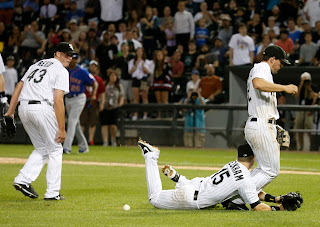 |
Ben Revere couldn't catch up to this Oswaldo Arcia
double during Tuesday's game in Target Field. |
The Twins entered last offseason with two more-or-less established leadoff-type center fielders in Denard Span and Ben Revere. By the end of the winter meetings, they had none.
And today, 61 games into the 2013 season, center field has to be seen as a significant failing of this roster. Aaron Hicks, the designated successor to Span as the center fielder and leadoff hitter, is on the disabled list with a strained hamstring and bruised batting average (.180). Joe Benson, once seen as a key component of a future Minnesota outfielder, hit under .200 in Triple A and was waived. Darin Mastroianni, whose purpose figures to be as a fourth outfielder -- speed off the bench --sustained an ankle injury at the end of spring training that ultimately required surgery.
Which leaves the Twins limping along with Clete Thomas in center for the time being. And raises the question: If the Twins had it to do over, would they still make the same trades?
There were two trades involved, one with Washington, the other with Philadelphia. As it turns out, the Twins just finished a series in Washington and are playing the Phillies now. Let's review:
Span to Washington for Alex Meyer: Span is hitting .277/.327/.374 for the Nationals, which is slightly below his career slash line but well within the range of expectations. Washington manager Davy Johnson has raved about Span's defense all year; having seen the Nats afield for a few games, Johnson may be enthused about Span's glove because the rest of the team is indifferent to bad in the field.
Meyer, generally regarded as the Twins' top pitching prospect, just went on the disabled list with Double A New Britain with what is described as shoulder discomfort; he has a 3.69 ERA in the Eastern League with 73 strikeouts in 61 innings.
This is not a trade for the Twins to regret at this point. The Twins never expected a 2013 payoff from this deal. Meyer will someday, health permitting, provide a power arm at the front of the Minnesota rotation, and that promise made dealing Span -- a good but not great player -- worthwhile.
Revere to Philadelphia for Vance Worley and Trevor May: Ugh.
Revere and Worley have been disappointments. Revere is hitting .244/.287/.274 for the Phillies, which ain't getting it done; even Hicks has a higher OPS+ (a stat that attempts to take league and ballpark biases out of the hitting numbers.
At least Revere's still in the majors. Worley, who started on Opening Day for the Twins, is now in Triple A and not thriving there either (1-5, 7.21 with the Twins, 1-3, 4.74 with the Red Wings).
The wild card (with wild being the operative word) to this trade is May, a hard-thrower who is, like Meyer, pitching in Double A (3.92, 28 walks and 54 strikeouts in 64.1 innings). The ERA is down almost a run per game from 2012 in the same league, but the walk rate is a tick higher and the strikeout rate a bit lower. There's not a lot of real progress visible in the numbers.
This one's a harder call. Revere is a deeply flawed player (no power, no throwing arm), and the notion of exchanging him for a mid-rotation guy (Worley) and a prospect lottery ticket (May) was one the Twins really could not pass on last December.
But now ... well, it seems pretty obvious that Hicks would have benefited from a 2013 in Triple A, May isn't progressing as hoped, and Worley has regressed from previous levels. Of course, the Revere of 2013 isn't worth playing in the majors either.
Statistically, this trade has been an exchange of trash, not that I'm calling any of these players garbage. Right now, I think Revere has the best chance of being a worthwhile major leaguer, although I'm back to seeing him more as a fourth-outfielder type rather than a regular.
The Twins had good reason to make the trade when they did, and they can't undo it regardless. Maybe the possibility that May will figure out how to throw strikes, or that Worley can regain his ability to get outs, is high enough that the Twins will ultimately be happy they made the deal. I don't think the Twins crippled themselves by giving up Revere. I'm still unwilling to call it a mistake by the Twins.














.jpg)















.jpg)
